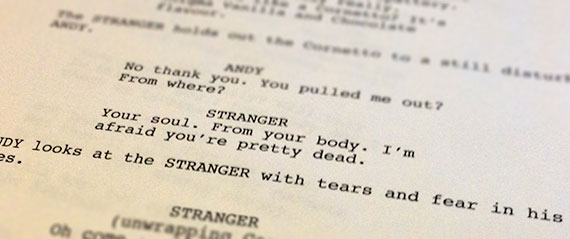My heartfelt thanks to Anne Flournoy for inviting me to participate in this blog tour; her timing was fortuitous. Anne is the powerhouse talent — writer, director, producer — of the comedy Web series The Louise Logs. It’s been over 25 years since we first met at festival screenings of our short films in New York City. Writing and life are coming full circle in many ways.
Find out more about Anne and her work: http://www.thelouiselog.com.
The format of this blog tour is to answer four questions and introduce two or three new writers. And so it begins:
What am I working on? I am writing poetic pieces again after a long hiatus. They are mostly short pieces. A few lines — sometimes a few pages. Mostly, the pieces share similar themes and even the same voice. They can connect as one larger work or not.
How does my work differ from others in its genre? Maybe it differs because I am not following any traditional or formal poetry rules or guidelines. I’m also thinking visually; how the words are placed on the page and how they would look off the page.
Why do I write what I do? It helps me make sense of the world, those around me, myself. It centers me — particularly because for a ‘living’ I do other types of writing (screenwriting, journalistic writing about films, and screenwriting articles and books), but poetry has always been a separate part of my creative brain. For a few years I couldn’t get back in that poetic-writing brain and I realized that in order to push through this was to acknowledge that at this point of my life, the only way I was going to find personal creative fulfillment was to write something short. If I wrote one line in one week, I felt good that I had accomplished this. Of course I agonized over every word in that one line, but I (eventually) put it down on paper.
How Does Your Writing Process Work?
There is no set writing process but I do find that the most productive time for me is before dawn. It’s quiet. My mind is quieter. (Sometimes it is not.) When I was a student at SUNY Purchase we did a writing exercise, taking words from book cover flaps and created poetry from that. A couple of years ago, I came across a box of those book covers and literal scraps of my old poems. It set me back in writing motion. It was freeing for me not to worry about originating a specific idea — I was so full of ideas I got in my own way as to how to start and then I got stuck and wrote nothing because I had no time. This prompted my process, which I continue today. I take words that spark me from whatever I am reading, type them up, rearrange them, sometimes I cut them out and collage them, and then I include my own words and make it my own. And from there, I keep writing. Listening to music also helps me. But not necessarily while I’m writing. Mostly when I’m driving. And it generally is something like Mahler or Brahms or Dvorak. Orchestral pieces I played as a violist. The structures used by these composers make sense to me in a way that organizes my thoughts, gives me peace, and challenges me. I listen just for the viola voice, the part I played, separating it out from the piece. The next part of my writing process is that when I feel that I have written a draft I’m comfortable with, I print it out and put it in a plastic sleeve and into a three-ring binder. Holding it in my hands feels tangible. Like a book.
And finally, here are two longtime writer/artist friends who are prolific, very smart, and generous of spirit. I have great admiration for them both. They inspire me. They will post blogs on this tour next Monday, June 9, but you can read what about them now.
THELMA ADAMS is the Contributing Editor at Yahoo! Movies. St. Martin’s Press published her debut novel PLAYDATE, an O magazine pick. She was the film critic at Us Weekly from 2000 – 2011, following six years at the New York Post. She has twice chaired the New York Film Critics Circle, where she has been a member since 1995. She has also written for Marie Claire, The New York Times Magazine, O: The Oprah Magazine, Parade, Variety, The Huffington Post, More, Interview Magazine, The New York Times, The international Herald Tribune, Cosmopolitan and Self. http://www.thelmadams.com/
LAUREN STRINGER writes and paints picture books, scripts, and designs sets for circus theatre in a big, pink Victorian House in Minneapolis, Minnesota, where she lives with her husband, her son, when he has not run off with the circus, her daughter, when she is home for the holidays, and three cats. Her first picture book, Mud, written by Mary Lyn Ray, won a Minnesota Book Award, IRA Children’s Choice Award, Crayola Kids Best Book of the Year Award and was declared a “Flying Starts” by Publisher’s Weekly. Since Mud, Lauren has continued illustrating many award-winning picture books, including Scarecrow and Snow, both written by Cynthia Rylant, Fold Me A Poem, written by Kristine O’Connell George, Our Family Tree: An Evolution Story, written by Lisa Westberg Peters, The Princess and Her Panther, written by Wendy Orr, and Tell Me About Your Day Today, written by Mem Fox. Her own Winter is the Warmest Season, was a Booklist Editor’s Choice and a finalist for the Minnesota Book Award. Her story When Stravinsky Met Nijinsky won the McKnight Foundation Fellowship for writing in Children’s Literature in 2012 and was a Booklist’s Top Ten Art Books for 2013 as well as an ALA Notable Book. Lauren’s latest illustrated picture book is Deer Dancer, written by Mary Lyn Ray. Read more about her books and circus life at: www.laurenstringer.com









